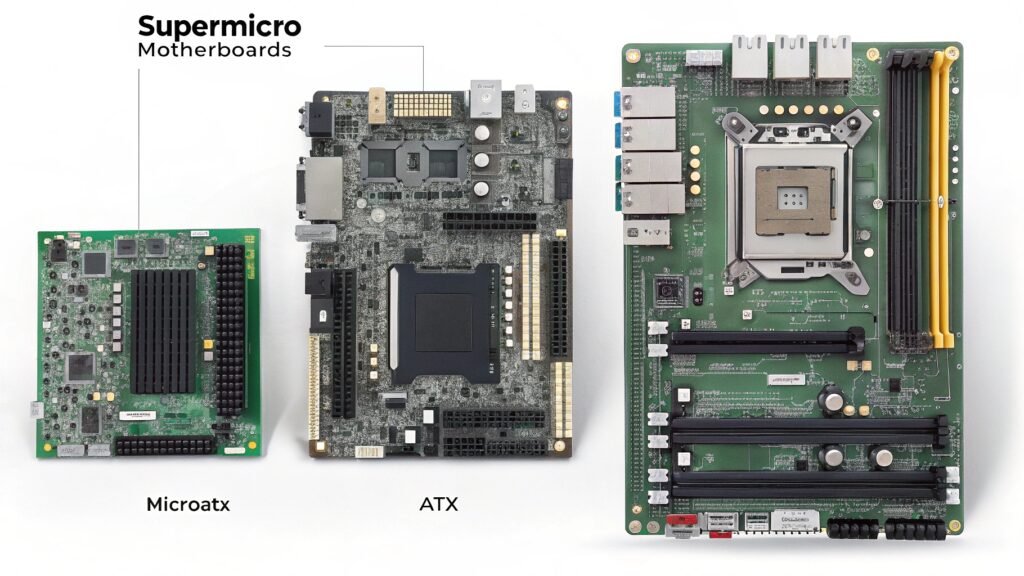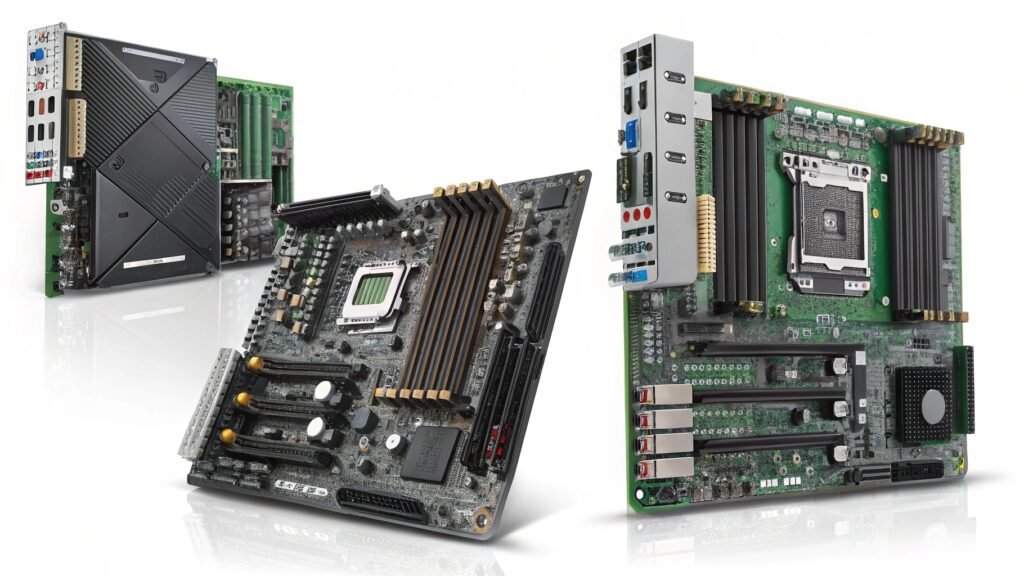Explore the best Supermicro motherboards for 2025 engineered for enterprise servers, AI workloads, HPC, and virtualization.
Learn about ECC memory support, IPMI remote access, AMD EPYC and Intel Xeon compatibility, and top models for data centers and workstations. Discover why Supermicro leads the industry in performance, scalability, and long-term reliability.
In the ever-evolving landscape of computing, the demand for high-performance, reliable, and scalable server hardware has never been greater. As data-intensive applications, cloud computing, AI, and virtualization become standard across industries, your hardware must deliver nonstop performance and flexibility.
That’s where Supermicro motherboards shine.
For over 30 years, Supermicro has delivered cutting-edge server motherboards built for mission-critical tasks. Unlike consumer brands focused on gaming or general productivity, Supermicro targets data centers, enterprise environments, high-performance computing (HPC), AI workloads, and embedded systems.
In this in-depth guide, we’ll explore:
- What makes Supermicro motherboards unique
- Supported platforms (Intel Xeon, AMD EPYC, Intel W-series, etc.)
- Form factors and build quality
- Top models in 2025
- Popular use cases and deployment scenarios
- Server management with IPMI and remote access
- How to choose the right Supermicro motherboard
- Real-world applications
Supermicro (Super Micro Computer, Inc.) designs and manufactures server-class motherboards optimized for maximum uptime, thermal efficiency, power optimization, and performance in professional and industrial environments.
Unlike typical desktop boards, Supermicro motherboards are:
- Designed for 24/7 workloads
- Built with higher-quality components (longer MTBF, better capacitors, ECC support)
- Compatible with rackmount and blade servers
- Feature-rich with BMC/IPMI for remote management
These motherboards are typically used in:
- Cloud and colocation data centers
- Enterprise IT infrastructures
- AI & ML research clusters
- Scientific computing labs
- Embedded and edge computing

Supermicro supports nearly every server form factor—designed to fit diverse rack and chassis requirements:
| Form Factor | Dimensions | Ideal For |
|---|---|---|
| ATX | 12″ x 9.6″ | Tower workstations and entry servers |
| E-ATX | 12″ x 13″ or larger | Dual CPU, AI, HPC, GPU servers |
| FlexATX | 9″ x 7.5″ | Compact appliances and routers |
| Mini-ITX | 6.7″ x 6.7″ | Edge computing and embedded systems |
| Proprietary | Varies (Blade, WIO) | High-density datacenter nodes |
| SSI-EEB/CEB | 13″ x 12″ | Dual socket and AI servers |
Supermicro’s proprietary form factors are often used in their:
- SuperBlade (modular computing)
- BigTwin/Ultra series (4-node and 8-node systems)
- MicroCloud and TwinPro (multi-node computing)
- Intel Xeon Scalable (LGA 4189, LGA 4677)
- AMD EPYC (SP3 and SP5)
- Intel Xeon W and Core-X
- Select support for Intel Core (i9, i7, i5) with ECC memory in workstation builds
- Most Supermicro boards support ECC RDIMM or LRDIMM
- Some support up to 4TB+ across 8–12 DIMM slots
- DDR4 and DDR5 compatibility depending on chipset
- Multiple SATA3, SAS3, U.2, and M.2 slots
- Support for RAID arrays, hot-swapping, and NVMe drives
- Boards often support Intel VROC and Broadcom RAID cards
- Up to 7 PCIe x16 slots
- Support for multi-GPU systems (NVIDIA H100, A100, RTX series)
- Expansion for network cards, RAID controllers, FPGAs
- Most boards feature ASPEED AST2600 or AST2500 BMC
- Integrated KVM-over-IP, virtual media, remote power cycling
- Fully compliant with IPMI 2.0 and Redfish standards
- Dual or quad Intel/Marvell NICs (1G, 10G, 25G, 100G)
- OCP 3.0 support on many models
- Optional Mellanox/Infiniband/SmartNIC compatibility

Here are some of the most powerful and popular Supermicro server boards by category:
- Supports 4th Gen Intel Xeon Scalable (Sapphire Rapids)
- 12 DDR5 DIMM slots per CPU
- PCIe 5.0, NVMe, 10G LAN, and IPMI
- Ideal for virtualization, high-density compute clusters
- Supports AMD EPYC 9004 (Genoa/Zen 4)
- PCIe Gen5 and DDR5
- Single socket, but high I/O throughput
- For dense compute workloads like AI/ML and scientific simulations
- Supports Intel Xeon W-3400 series
- W790 chipset, DDR5, PCIe 5.0
- Designed for creative professionals, developers, and GPU-heavy workloads
- LGA 1200, Intel Xeon E-2300 support
- Micro-ATX, IPMI, ECC, SATA RAID
- Best for file servers, mail servers, and SMB IT
- Embedded Intel Atom CPU
- Passive cooling, 4x LAN ports, IPMI
- Ideal for IoT, edge processing, or security appliances
Used by Fortune 500 companies, Supermicro motherboards power:
- CRM, ERP, and SQL servers
- Scalable storage servers (ZFS, Ceph, Gluster)
- Virtualized environments (VMware, Proxmox, Hyper-V)
For engineers, architects, video editors, and 3D designers:
- Multi-GPU rendering
- CAD/CAM software optimization
- VR and AR development platforms
- Support for compute nodes and head nodes in HPC setups
- Genomics, weather modeling, deep learning training
- CPanel, Plesk, containerized apps (Docker, Kubernetes)
- Blade servers for multi-tenant hosting
- Hyperconverged infrastructure deployments
- Rugged boards used in factory floors, transport systems
- Router/firewall appliances (pfSense, OPNsense, VyOS)
- Determine Your Use Case:
Server hosting? AI training? Edge processing? - Check CPU and Socket Compatibility:
LGA 4677 (Intel), SP5 (AMD), or embedded SoC? - Confirm Memory Needs:
DDR4 or DDR5? ECC? RDIMM or LRDIMM? - PCIe and Expansion Requirements:
GPU slots? RAID? Additional NICs? - Form Factor Fit:
Rackmount vs. tower vs. embedded chassis - IPMI Needs:
Remote management required? Ensure BMC and KVM-over-IP are included.
| Brand | Strengths | Weaknesses |
|---|---|---|
| Supermicro | Enterprise reliability, remote management, ECC | Less consumer-friendly interface |
| ASUS | Workstation and creator boards | Limited IPMI options |
| ASRock Rack | Affordable server-grade options | Fewer advanced BMC/IPMI tools |
| Gigabyte Server | Strong in HPC and edge platforms | Limited availability in some regions |
| Dell/HP OEM | Pre-integrated solutions | Less flexible for DIY/custom builds |
echnically yes, but it’s overkill. They’re not optimized for RGB, overclocking, or fast refresh rates. However, for streamers using multi-GPU setups or creative professionals, they are excellent.
Yes. Most models use ECC Registered DIMMs (RDIMM/LRDIMM), not standard consumer memory.
Supermicro boards support Windows Server, Red Hat, Ubuntu, FreeBSD, VMware ESXi, and more.
They’re not plug-and-play like gaming boards. You’ll need to be familiar with BIOS, IPMI tools, and potentially Linux CLI.
Available through authorized distributors like Newegg Business, CDW, Supermicro Direct, and enterprise IT integrators.
If your priority is performance, reliability, and enterprise scalability, there is no better option than a Supermicro motherboard. Whether you’re building a server cluster, high-end workstation, AI development platform, or embedded industrial system, Supermicro delivers industry-grade engineering backed by decades of innovation.
For developers, IT architects, engineers, and data-driven enterprises, Supermicro motherboards provide a solid foundation built not just to perform, but to last.
Mini ATX Motherboard: The Ultimate Guide to Compact PC Power in 2025
What Motherboard Should 5600X Support? A Complete Compatibility & Buying Guide
ASUS ProArt Motherboard Temperature Sensor Location: Full Guide for Optimal Thermal Monitoring
